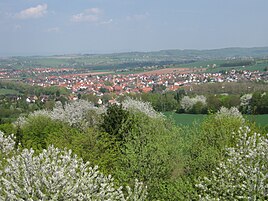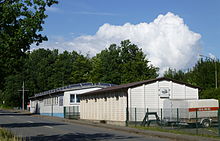Gerblingerode
|
Gerblingerode
City of Duderstadt
|
||
|---|---|---|
| Coordinates: 51 ° 29 ′ 39 ″ N , 10 ° 15 ′ 43 ″ E | ||
| Height : | 186 m above sea level NN | |
| Residents : | 1807 (Nov. 1, 2019) | |
| Incorporation : | 1st January 1973 | |
| Postal code : | 37115 | |
| Area code : | 05527 | |
|
Location of Gerblingerode in Lower Saxony |
||
|
View from the horse mountain to Gerblingerode
|
||
Gerblingerode is a place in the district of Göttingen in Lower Saxony . The village, which belongs to the Untereichsfeld , has been part of the city of Duderstadt since January 1, 1973 and has around 1,800 inhabitants.
Geographical location
Gerblingerode is about 21 kilometers east of Göttingen, directly on the former inner-German border and today's Lower Saxony- Thuringia border. The location is in the Hahletal on the federal highway 247 between Teistungen and Duderstadt. The highest point in the Gemarking is the Pferdeberg (280.4 m).
history
Gerblingerode was first mentioned in 1151 as Gerewardingeroth . This mention was made in the chronicle of the convent Lippoldsberg instead, being indicated that in its possessions also tithe in Cherewardingeroth belonged. From 1432 to 1815 the place was a council village of the city of Duderstadt. Gerblingerode was obliged to deliver goods in kind and services. During the Peasants' War , the peasant army encamped for one day between Gerblingerode and Duderstadt in May 1525, their leaders, Thomas Müntzer and Heinrich Pfeiffer , quartered themselves in the church at Gerblingerode, where they waited for a delegation from Duderstadt. The mayor of Duderstadt, Hesse, managed to get Müntzer to refrain from destroying Duderstadt. One of the leaders discovered a chalice in the tabernacle of the church which the provost of Teistungenburg had placed there, desecrated it and took the chalice as booty. Similar to the other villages of the Untereichsfeld , Gerblingerode also suffered from the wars of the 17th and 18th centuries. The place suffered looting and was obliged to billet and make contributions , including bread, meat, grain and beer. In 1630, General Tilly made the city of Duderstadt and its council villages a total of 21,000 Reichstalers , whereby between 1632 and 1636 the Ratsdörfer paid the sum of 18,400 Reichstalers to the Elector of Braunschweig and the Duke of Braunschweig . Gerblingerode delivered 144 Reichstaler, 21 Groschen and 11 Pfennig in 1636 for contribution purposes. Further payments, albeit in kind, are documented for the village in 1645. After the end of the Thirty Years' War, the town continued to suffer from armies moving through, so in 1675 and 1705 Hanoverian and Brandenburg troops passed through Gerblingerode and took up quarters there.
Between the years 1700 and 1718 the population development of Gerblingerode stagnated until it came down again in the years between 1718 and 1744. The reasons for this are the noticeable shortage, the high price increases in 1720, which caused many Eichsfelder to emigrate to Hungary , as well as the cattle epidemics of 1724/1725, abnormalities and a major fire of March 11, 1718, in which from the total of 33 houses 25 were laid in rubble. An epidemic fever struck the population of Duderstadt in the years 1737/1738 and also spread to Gerblingerode. With the introduction of manufactories and looms from 1750 onwards, the population continued to grow until 1816, so in 1772 there were already 52 woolen weavers residing in Gerblingerode who carried out this craft as a secondary activity. At the same time, there was also a structural change, as one could now concentrate more on manufacturing and gradually turned away from agriculture and the associated handicrafts. By 1816 the population of the place should have tripled, at that time the place, with its inhabitants, took fourth place within the 11 town councils of Duderstadt.
In the Seven Years' War Gerblingerode suffered further setbacks as it was indirectly involved in the clashes between Prussia and Austria . This happened because the Elector of Mainz, Johann Friedrich Karl , took the side of Maria Theresa , so that the Eichsfeld was surrounded on all sides by enemies, since its Protestant neighboring areas supported the Prussian King Friedrich II . This alliance with Austria should cost Eichsfeld dearly, as one can see from the example of Gerblingerode. When Hanoverian troops invaded Eichsfeld in 1758, all single-horse horses were obliged to carry out forage drives into the lands of Kurhannovers . The farmers from Gerblingerode had four loads to do between December 4, 1758 and February 25, 1759. Furthermore, the place was obliged to billet, carry out provisions and contribution payments . For the year 1759, a total of 173 Reichstaler, 22 Groschen and 4 Pfennigen is given for these payments. Four years later, the payments also include contributions in kind in the form of 19 horses, 50 cattle and 32 sheep. The reason for the additional taxes was the “extraordinary” head, property and food tax introduced by Prussia in February 1763. As a final tax, Prussia introduced the fire protection tax in the same year, which amounted to Reichstaler, 6 groschen and 6 pfennigs in 1739. The enormous strain under which Gerblingerode suffered from 1756 to 1763 was underscored by the numerous marches and billeting of French, Prussian, Allied, Hanoverian and Hessian troops. The total cost was 18,773 princely guilders and 54 three-quarter cruisers.
After the Second World War, Gerblingerode was, like the entire sub-area, in the British zone of occupation ; The inner-German border ran just under a kilometer south of the village . The Duderstadt / Worbis border crossing was set up at this in 1972 and could be used for " small border traffic ". On January 1, 1973 Gerblingerode was incorporated into Duderstadt.
The local coat of arms
The local coat of arms is divided into two parts and is held in gold, black and red. The upper part shows two black abbess staffs on a gold background. These symbolize the affiliation to the Cistercian convent Teistungenburg . The nearby monastery owned numerous buildings and properties in the parish in earlier times and also consecrated the local priest. At the same time, Gerblingerode naturally also belonged to the city of Duderstadt and that is why the city's coat of arms was included in its own. This can be seen in two golden lions ("leopards, see coat of arms") on a red background in the lower half of the coat of arms.
Gerblingerode has had the coat of arms in its current form and color since June 2, 1951.
Attractions
Church of the Nativity of Mary
The yellow, slate-covered clinker brick building , which dates from 1970, represents the relatively young Catholic Church of the Birth of Mary. It also has a free-standing, 32 m high bell tower made of three diagonally arranged concrete pillars and is crowned by a three-sided cross with a height of 2.50 m. At least two previous buildings existed before the current church building: A chapel from the 13th / 14th. Century and a neo-Gothic brick building , which was built in 1895 according to the plans of Paschalis Gratze OFM . Gratze designed various church buildings in Eichsfeld (e.g. for Breitenberg or Effelder ). The Braunschweig architect Wolfgang sealed deer joke aimed at the establishment of the new parish church to a structural unit of the sacral space and the affiliated side rooms. They should serve as a parish center. The church interior is an elongated hexagon and is spanned by a wood-paneled pyramid ceiling. The tabernacle is located in the spacious chancel in the western area of the church, which is raised by a few steps . It was made of colored enamel and copper and has a geometric ornamentation. The altar , on the other hand, is block-like and made of white stone , above which a baroque crucifix is attached. It is backed by an ornamented metal plate in a modified cross shape. The former center of the Marian pilgrimage mentioned in 1439, a Gothic Maria-Kind group, found a new place to the side of the altar in front of a white stone block with a flame-like mandorla . The ceiling is broken through by skylights , next to it on the north wall there are four colored glass windows with depictions of the Passion . Since November 1, 2014, the church has belonged to the parish of St. Cyriakus , based in Duderstadt.
Frontier Museum
The Grenzlandmuseum Eichsfeld is located south of the village towards Teistungen on the former inner-German border, the Grenzlandweg leads over the Pferdeberg.
politics
Local council
The local council consists of eleven council members and councilors.
(As of: local election on September 11, 2011 )
Local mayor
The local mayor is Dieter Thriene ( CDU ).
Economy and Infrastructure
With the introduction of tobacco growing in Duderstadt in 1660, the planting of the crop spread relatively quickly throughout the entire area of the Eichsfeld. Sufficient human labor, which was able to compensate for the low labor input of animals, made it possible to cultivate tobacco in Gerblingerode. While the numbers about the planters in the early years are still in the dark, records from 1843 show that 83 planters were already resident in the village. By 1938 the number was to rise to 140. The great importance that tobacco had for Gerblingerode meant that Engelhardt and Biermann opened their second cigar factory in January 1875, the first was built in Duderstadt in 1871. In addition to the production of the cigars in the factory, there was also the production of the same in homework. In 1912, 12% of Eichsfeld's cigar production was done from home, in Gerblingerode in 1914 a total of nine people produced cigars from home. This time also describes the heyday of local cigar production with the largest number of employees. In the following decades of the 20th century, the total number of workers decreased continuously, so in 1921 there were 75 workers, while in 1965 there were only 33 people. The year 1965 also marks the closure of the Gerblingeröder cigar factory, which closed its doors on February 26th.
literature
- Hans Geisenhanslüke: Gerblingerode. Historical development of a village . Mecke, Duderstadt 2001, ISBN 978-3-932752-76-6 .
Web links
Individual evidence
- ↑ Population statistics on the city of Duderstadt's website, accessed on May 7, 2020.
- ^ Federal Statistical Office (ed.): Historical municipality directory for the Federal Republic of Germany. Name, border and key number changes in municipalities, counties and administrative districts from May 27, 1970 to December 31, 1982 . W. Kohlhammer GmbH, Stuttgart and Mainz 1983, ISBN 3-17-003263-1 , p. 206 .
- ↑ Hans Geisenhanslüke: Gerblingerode. Historical development of a village . Mecke, Duderstadt 2001, p. 43 .
- ^ Federal Statistical Office (ed.): Historical municipality directory for the Federal Republic of Germany. Name, border and key number changes in municipalities, counties and administrative districts from May 27, 1970 to December 31, 1982 . W. Kohlhammer GmbH, Stuttgart / Mainz 1983, ISBN 3-17-003263-1 , p. 206 .
- ↑ Parish Gerblingerode: Home - Parish Gerblingerode. In: www.pfarrgemeinde-gerblingerode.de. Retrieved April 28, 2016 .
- ↑ http://wahlen.kds.de/2011kw/Daten/152007_000068/index.html






